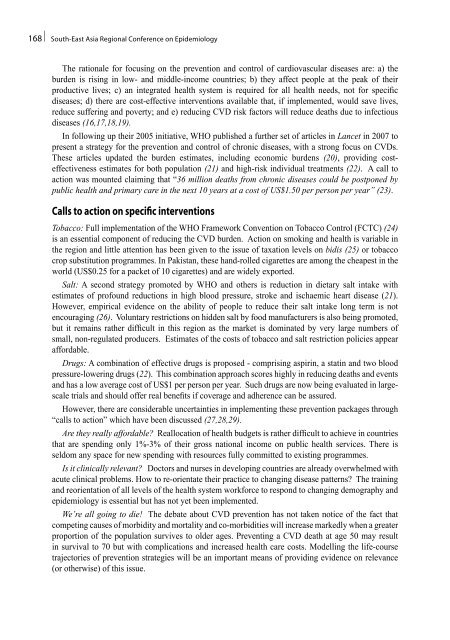South-East Asia Regional Conference on Epidemiology
South-East Asia Regional Conference on Epidemiology
South-East Asia Regional Conference on Epidemiology
Create successful ePaper yourself
Turn your PDF publications into a flip-book with our unique Google optimized e-Paper software.
168 | <str<strong>on</strong>g>South</str<strong>on</strong>g>-<str<strong>on</strong>g>East</str<strong>on</strong>g> <str<strong>on</strong>g>Asia</str<strong>on</strong>g> <str<strong>on</strong>g>Regi<strong>on</strong>al</str<strong>on</strong>g> <str<strong>on</strong>g>C<strong>on</strong>ference</str<strong>on</strong>g> <strong>on</strong> <strong>Epidemiology</strong><br />
The rati<strong>on</strong>ale for focusing <strong>on</strong> the preventi<strong>on</strong> and c<strong>on</strong>trol of cardiovascular diseases are: a) the<br />
burden is rising in low- and middle-income countries; b) they affect people at the peak of their<br />
productive lives; c) an integrated health system is required for all health needs, not for specific<br />
diseases; d) there are cost-effective interventi<strong>on</strong>s available that, if implemented, would save lives,<br />
reduce suffering and poverty; and e) reducing CVD risk factors will reduce deaths due to infectious<br />
diseases (16,17,18,19).<br />
In following up their 2005 initiative, WHO published a further set of articles in Lancet in 2007 to<br />
present a strategy for the preventi<strong>on</strong> and c<strong>on</strong>trol of chr<strong>on</strong>ic diseases, with a str<strong>on</strong>g focus <strong>on</strong> CVDs.<br />
These articles updated the burden estimates, including ec<strong>on</strong>omic burdens (20), providing costeffectiveness<br />
estimates for both populati<strong>on</strong> (21) and high-risk individual treatments (22). A call to<br />
acti<strong>on</strong> was mounted claiming that “36 milli<strong>on</strong> deaths from chr<strong>on</strong>ic diseases could be postp<strong>on</strong>ed by<br />
public health and primary care in the next 10 years at a cost of US$1.50 per pers<strong>on</strong> per year” (23).<br />
Calls to acti<strong>on</strong> <strong>on</strong> specific interventi<strong>on</strong>s<br />
Tobacco: Full implementati<strong>on</strong> of the WHO Framework C<strong>on</strong>venti<strong>on</strong> <strong>on</strong> Tobacco C<strong>on</strong>trol (FCTC) (24)<br />
is an essential comp<strong>on</strong>ent of reducing the CVD burden. Acti<strong>on</strong> <strong>on</strong> smoking and health is variable in<br />
the regi<strong>on</strong> and little attenti<strong>on</strong> has been given to the issue of taxati<strong>on</strong> levels <strong>on</strong> bidis (25) or tobacco<br />
crop substituti<strong>on</strong> programmes. In Pakistan, these hand-rolled cigarettes are am<strong>on</strong>g the cheapest in the<br />
world (US$0.25 for a packet of 10 cigarettes) and are widely exported.<br />
Salt: A sec<strong>on</strong>d strategy promoted by WHO and others is reducti<strong>on</strong> in dietary salt intake with<br />
estimates of profound reducti<strong>on</strong>s in high blood pressure, stroke and ischaemic heart disease (21).<br />
However, empirical evidence <strong>on</strong> the ability of people to reduce their salt intake l<strong>on</strong>g term is not<br />
encouraging (26). Voluntary restricti<strong>on</strong>s <strong>on</strong> hidden salt by food manufacturers is also being promoted,<br />
but it remains rather difficult in this regi<strong>on</strong> as the market is dominated by very large numbers of<br />
small, n<strong>on</strong>-regulated producers. Estimates of the costs of tobacco and salt restricti<strong>on</strong> policies appear<br />
affordable.<br />
Drugs: A combinati<strong>on</strong> of effective drugs is proposed - comprising aspirin, a statin and two blood<br />
pressure-lowering drugs (22). This combinati<strong>on</strong> approach scores highly in reducing deaths and events<br />
and has a low average cost of US$1 per pers<strong>on</strong> per year. Such drugs are now being evaluated in largescale<br />
trials and should offer real benefits if coverage and adherence can be assured.<br />
However, there are c<strong>on</strong>siderable uncertainties in implementing these preventi<strong>on</strong> packages through<br />
“calls to acti<strong>on</strong>” which have been discussed (27,28,29).<br />
Are they really affordable? Reallocati<strong>on</strong> of health budgets is rather difficult to achieve in countries<br />
that are spending <strong>on</strong>ly 1%-3% of their gross nati<strong>on</strong>al income <strong>on</strong> public health services. There is<br />
seldom any space for new spending with resources fully committed to existing programmes.<br />
Is it clinically relevant? Doctors and nurses in developing countries are already overwhelmed with<br />
acute clinical problems. How to re-orientate their practice to changing disease patterns? The training<br />
and reorientati<strong>on</strong> of all levels of the health system workforce to resp<strong>on</strong>d to changing demography and<br />
epidemiology is essential but has not yet been implemented.<br />
We’re all going to die! The debate about CVD preventi<strong>on</strong> has not taken notice of the fact that<br />
competing causes of morbidity and mortality and co-morbidities will increase markedly when a greater<br />
proporti<strong>on</strong> of the populati<strong>on</strong> survives to older ages. Preventing a CVD death at age 50 may result<br />
in survival to 70 but with complicati<strong>on</strong>s and increased health care costs. Modelling the life-course<br />
trajectories of preventi<strong>on</strong> strategies will be an important means of providing evidence <strong>on</strong> relevance<br />
(or otherwise) of this issue.









